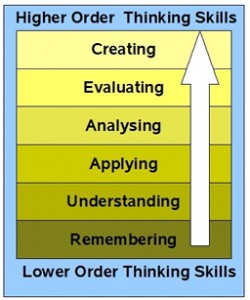Teachers only teach what they were taught. Most teachers were taught traditional methods of direct instruction. Theorists like Dewey, Piaget, and Vygotsky focused on students being more responsible for their learning. Papert focused on constructivism where students make learning happen. Montessori focused on preschool children learning through play. The Reggio Emilio approach, started in Italy after World War II, encourages preschool children to proactively participate in discovery learning while adults chronicle their progress. Bruner focused his research on discovery learning where students are encouraged to learn on their own through action and experience.
Each student is unique. Students learn at different rates and have multiple learning styles and intelligences. (Garner’s Theory of Multiple Intellligences) When you look at how we teach, most teachers are still at the knowledge or remembering level of Bloom’s Taxonomy. (Andrew Church revision of Bloom’s Taxonomy below)
Teacher-center vs student-centered classroom
| Teacher-centered | Student-centered |
| Traditional | Progressive |
| Standards-driven | Curriculum-driven |
| Factory model | Inquiry model |
| Breadth | Depth |
| Single Subjects and grade level focus |
Thematic and real world applications |
| Depth | Breadth |
| Focused on Product | Focused on Process |
| Process- and product-oriented | Product-oriented |
| Short time on each concept | Block scheduling and cross curricular activities |
| Isolated teaching and learning | Collaborative activities for students and teachers |
| Rote knowledge | Experiential knowledge |
Students can be more involved in the decisions of how they learn and what they learn. If they are aware of the standards and tests they need to learn, they can even help teachers design activities that engage them and help them understand the concepts. Most students zone out after 1-2 minutes of anyone talking at them. If they are accountable for a presentation, song, skit, poster, or an exhibit, they take more ownership of the product. The product really doesn’t matter as much as the process, but to the students, it means alot. Writing an essay that only the teacher reads doesn’t mean anything to them. If their peers read their essays, that’s another story. If they have to do a showcase of their work and their parents or others in the school community see it, then they really care. If their work is published on the Internet, then they will work on it overtime, on breaks, after-school. The engagement factor explodes.
So the important piece here is to tie in any projects or student-centered activities with standards. As long as we use tests and standards as measurement of student achievement, we have to do this to show that this type of classroom works. Eventually, we need other means of assessment that are more authentic.
To move to this type of classroom takes time, patience, and being okay with taking risks and learning from failure. That is tough for today’s teachers that are accountable for scores based on standardized tests. What I suggest is to start slowly. If you are a teacher who wants to move in this direction, here are some steps you can take:
- discuss what you want to do with your administrator
- introduce the new Bloom’s Taxonomy to your grade level or department
- identify gaps in learning by analyzing student data
- choose one area where you can design one project or lesson that includes inquiry
- check the resources you have available first before you even start planning
- sit with a coach or colleague to redesign a lesson to include a more hands-on approach to learning
- ask your coach to model some of the strategies for you or explain to your students honestly what you want to do and ask for their help
- involve students in more of the design of questions and the type of products they will be presenting
A strong leader helps. If your students have access to computers and the Internet, they can work in groups. Talking about technology is another post.




[…] This post was mentioned on Twitter by Bertromavich Reibold and Barbara Bray, Barbara Bray. Barbara Bray said: Moving to Student-Centered Classrooms http://goo.gl/fb/GYvz8 […]